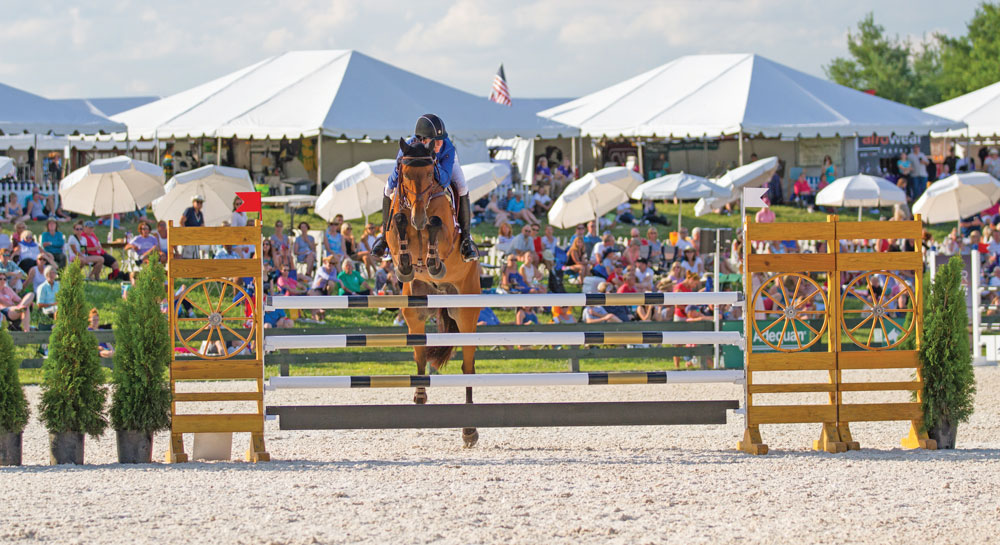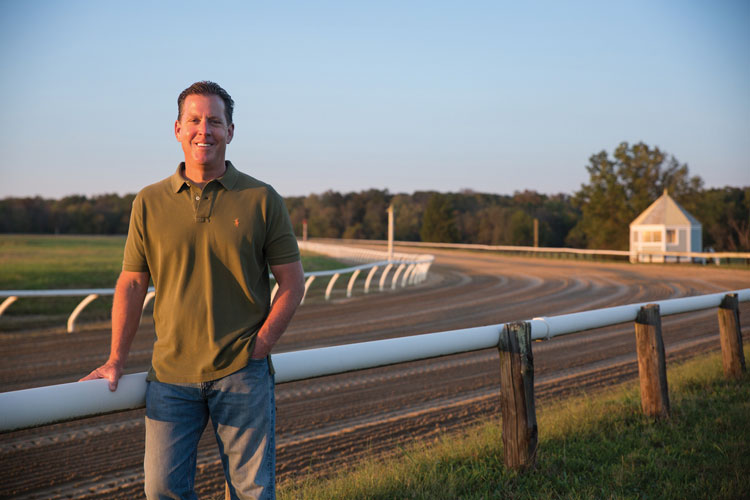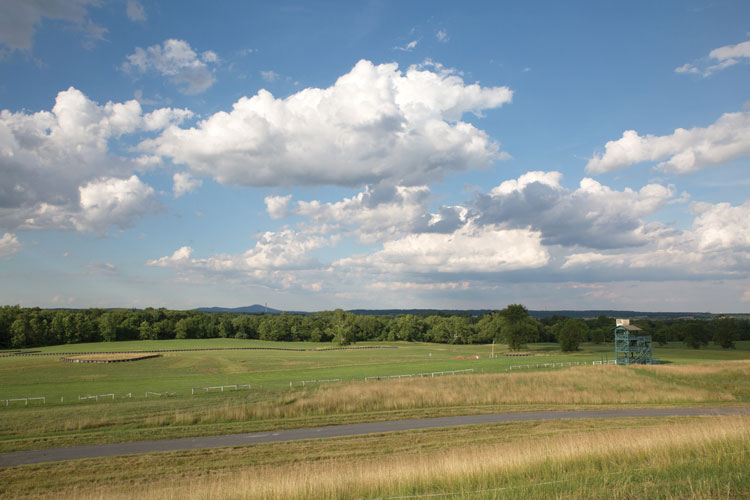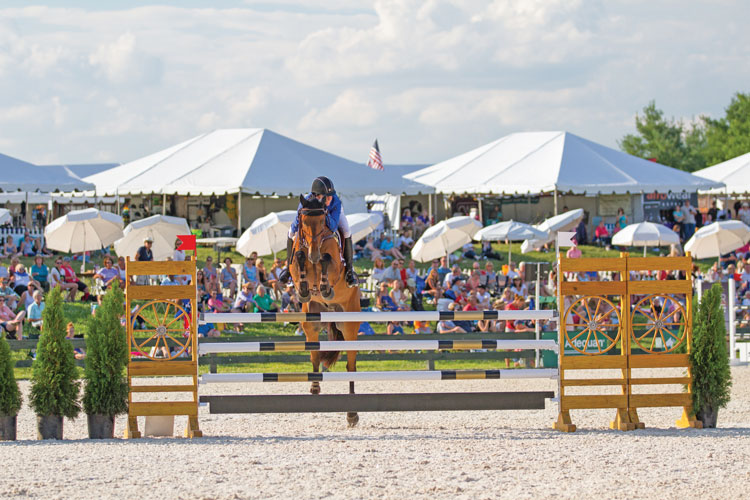Building The Big Business of Equine Sports

Story and photos by Callie Broaddus
If you build it, they will come.
Or, at least, that’s the bet a few area equine facility owners and managers are making as they spend millions to bring their historic properties up to world-class competition standards. It may seem a silly question to ask, but why is there such a wave of investment into equine facilities now? Are these facilities all going after the same piece of the equestrian pie?
MIDDLEBURG TRAINING CENTER
The most nascent of the large-scale facility improvements this article will visit broke ground early this summer, when Purcellville resident Chuck Kuhn purchased the derelict Middleburg Training Center for $1.5 million from the Thoroughbred Retirement Foundation. Kuhn, founder and owner of JK Moving Services, is well-known for his dedication to preserving open space. On October 12 of this year, Kuhn was awarded the Commonwealth Steward Award for placing more than 1,000 acres of Virginia countryside into easement.

When Leesburg-based attorney David Moyes contacted Kuhn earlier this year about the beautiful and historic Middleburg Training Center, he found a ready audience. “He grew up racing on this track as a kid, so that’s the guy that I have to blame for this,” says Kuhn with a laugh.
Moyes told Kuhn that developers were looking at the property, and he wanted someone to get it under easement. “That’s what sucked me into it, and that was the sole intention. So that’s what I was excited about, most passionate about. Now I’m excited about trying to get it back to where it was,” says Kuhn, elaborating that the training center was “the cat’s meow” during the 1950s and 1960s, when Paul Mellon built and operated the facility.
The property features 11 barns, 220 stalls, 22 paddocks and a picturesque 7/8-mile racetrack on 149 acres, all within a seven-minute drive northwest of Middleburg. “When we came in, the grass was three feet high, the track was a mess, the barns were a mess, and we’re slowly taking it down. So, we’re going to put about a $2 million investment into renovating the barns and the track,” says Kuhn, with pep in his voice.
“This was really about the conservation easement, protecting the open space,” he adds. “It won’t be the next retirement for me by any means, but I do think it can sustain itself. I think it can continue to grow, and I think it can be a profitable venture. But it’s going to take some time.”
Kuhn plans to rebrand the facility under the name Middleburg Equine Center, and he’s set his sights on bringing eventing to the property in a manner that compliments the events at Morven Park in Leesburg and Great Meadow in The Plains. “We’re starting to add quality tenants,” he says. “And then when we add the other disciplines, we’re going to get this thing alive again.”
MORVEN PARK

Twenty-four miles northeast of Kuhn’s new farm sits the iconic International Equestrian Center at Morven Park.
“What was once the training ground for the best eventing riders in the country, from Pony Club through Olympic Games, has become a well-used facility in need of improvements,” says Sheryl Williams, the COO and Interim Executive Director at Morven Park following the departure of Stephanie Kenyon. “Today’s competitions require facilities beyond those which were acceptable 40 years ago, when Morven Park’s International Equestrian Center was first built.”
The historic facility embarked on a multi-year master site plan in 2012, the first phase of which is currently underway, with one of the two new infield arenas already completed. Phase I is expected to cost $4.4 million and will include a racecourse renovation and grand prix arena in addition to the two infield arenas.*
“Morven Park has long been and remains one of the few facilities in the area that can accommodate so many different disciplines and large numbers of competitors,” says Williams. “Our competitions today include eventing, dressage, hunter/jumper, polo and carriage driving. Racing will be returning as well. Our business was outgrowing our ability to meet the needs of our existing clientele.”
Williams’ team has managed to raise $2.5 million of the needed $4.4 million to complete Phase I. Because she will have to dip into the facility’s maintenance reserve to temporarily cover the $1.9 million gap in funding, Williams hopes to bring in new revenue from competitors, spectators and casual riders coming to take advantage of such a uniquely versatile facility.
GREAT MEADOW

Rob Banner, President of The Great Meadow Foundation, mixes a passion for conservation with a long personal history in horse sports.
“If we anchor the area in equestrianism, it will always be defensible against development,” says Banner, explaining his “30,000-foot view” approach to the facility renovation at Great Meadow, which was completed in the spring of 2016.
Great Meadow’s well-publicized renovation project involved a $4.5 million investment, adding a top-of-the-line cross-country course and two arenas, the 300’ x 250’ main arena and a 400’ x 100’ warm-up ring. The expansion also involved acquiring approximately 175 acres, nearly doubling the size of the property, and placing the whole property under conservation easement.
The renovation is part of Banner’s laser-focused effort to raise the bar of competition at Great Meadow. “If we’re able to bring in the very best horses, then we’ll certainly bring the spectators,” says Banner. “We’ll bring crowds that want to see the German team or the British team or the Irish team compete against the U.S. team.”
Banner is also a tireless promoter of the proposed USDA-approved quarantine center at the Dulles International Airport, which would enable horses to fly from Europe directly to Middleburg’s front door. “If we’re to get better horse sport, we have to face Europe on our own soil,” says Banner, noting that Virginia’s horse country is an ideal location for international-level competition. “Not only is it easy to go back and forth to Europe, but we have great footing in all the places where we compete.”
While two of Great Meadow’s long-held sporting events, the Virginia Gold Cup and International Gold Cup, are well established steeplechase fixtures, the July FEI Nation’s Cup™ CICO*** event is gaining its footing. Just this week, Banner secured a three-year contract with equine air transportation company Horse America as the title sponsor of the event, which will officially be called the Horse America Great Meadow International, presented by Adequan. Horse America is a wholly-owned subsidiary of Brook Ledge Horse Transportation.
This fall, Great Meadow came runner-up to Fair Hill in the bid for a proposed FEI CCI**** event. Banner attributes that loss in part to Maryland’s greater recognition of the economic impact the proposed event could bring. “They understood it was a $30 million impact to tourism in that area,” he says. “It creates an economic impact that cannot be ignored. And the jobs are farriers, feed vendors, veterinarians, as well as hotels and restaurants and up and down the ladder.”
Banner allows a rare momentary pause. “Equestrian is not just the preservation of open space,” he says. “It’s big business.”
UPPERVILLE COLT & HORSE SHOW
In the business of the nation’s oldest horse show, an extensive facilities upgrade contributed to a boom in entries, which had struggled to rebound after the recession. At its peak in 2008, the Upperville Colt and Horse Show tallied 1,627 horse-and-rider combinations, 41 percent of which trailered in from Virginia. But by the next year, the famous show had lost 30 percent of its entries—dropping to 1,130—and from a much more local audience; 59 percent came from within the Commonwealth.
For four straight years, entries hovered around 1,130. Competitors grew more vocal about the need for improved footing, and a few patrons donated generously to initiate the improvements. Changes were slowly implemented over the next five years, corresponding with a slight uptick in entries.
However, in 2017, the 164th Upperville Colt and Horse Show suddenly bucked the gradual growth trend and registered 1,545 entries, a 28 percent increase over the previous seven year average.** Notably, the percentage of in-state competitors dropped to 40 percent, its lowest in more than a decade at least (no data being available before 2007).
While these numbers are similar to those recorded in 2008, there is one statistic that doesn’t match up. The percentage of entries trailering in from Florida rose sharply to 14 percent in 2017, whereas only 4 percent of competitors in 2008 came from the sunshine state. To put that into more tangible numbers, 151 more Floridian horses filled the barns this year than in the peak entry year of 2008.
While that statistic could simply be anomalous, it could also indicate a new equestrian demographic willing to travel to compete at a venue the quality of the Upperville showgrounds.
“The horse show is an incredibly improved facility—vastly improved,” remarks Olympic gold medalist Joe Fargis, who sits on the horse show board. “The schedule, the footing, the money, everything. It’s just improved, and it’s a nice destination.”
While the swell in entry fees is good for the horse show, being a destination for out-of-state riders is a boon for the local economy. Traveling competitors contribute tourism dollars into retail and hospitality industries and become new customers for local veterinarians, farriers, hay suppliers and other horse industry businesses.
One might find it counterintuitive that the people behind each of these major projects would root for each other’s success. When so much capital is involved, it’s not likely assumed that camaraderie is part of the package. But as Williams puts it, “We are all resources that cater to differing portions of the equestrian market.”
“Look at auto dealerships today,” says Kuhn. “It used to be there would be an auto dealer on one side of town and an auto dealer on the other side of town. Now they do the auto parks. And I’m kind of looking at the same thing here with the equine. Bring ‘em all in. It’s a big industry here—it’s a billion-dollar industry here. And I think a rising tide will float all of us.” ML
*For a more detailed breakdown, visit middleburglife.com/morven-park-equestrian-center. **Data from the 2014 Upperville Colt and Horse Show was incomplete, and was therefore omitted from calculations. The data available was consistent with the adjacent years.


